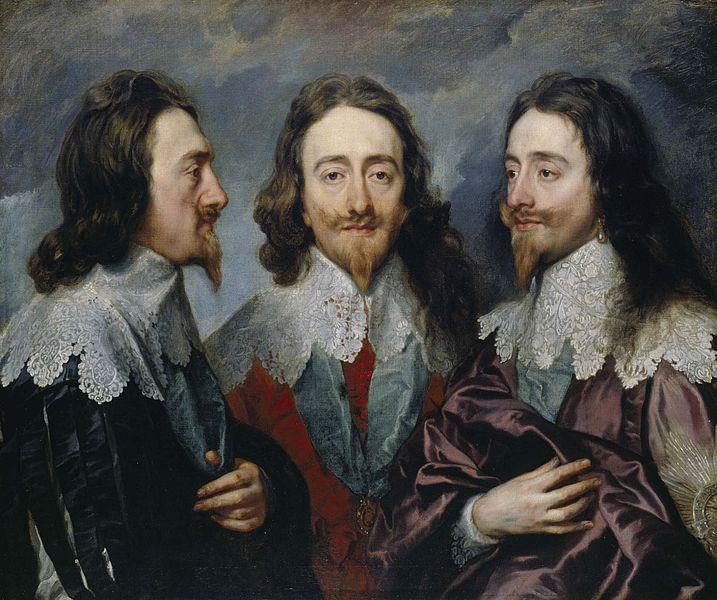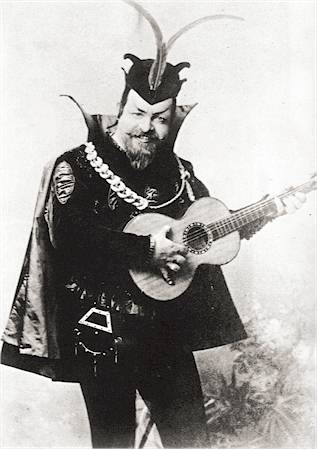Where the Devil Got His Face

Today we continue the devilish theme of the previous post with a historical discursion on the iconography of the Devil and its surprising origin, according to a German scholar.
WHERE HIS SATANIC MAJESTY GOT HIS FACE
Special Correspondent of the Enquirer
London, May 26, 1904
Where did the devil get his face—the familiar satanic type of countenance; that is to say, with the peculiar mustache and chin beard, such as are invariably worn by the stage Mephistopheles?
The answer is: From Charles I, the English monarch, and the discovery is certainly the most interesting of recent achievements in historical research. It is credited to Prof. Ludwig Schmidt, of the University of Bonne, in Germany, who, in support of his theory, has been able to assemble such proofs as appear to render its correctness altogether beyond dispute.
It seems hard to believe, in these modern times, when the devil has become a humorous, almost a comic figure, that, not so very long ago, he was as real a personage to the generality of mankind as Emperor William, say, or the Czar of Russia is today. Yet such was undeniably the case, and, while nobody then thought of doubting his existence as a terrifying fact, his influence in all human affairs was so great that not even the most saintly individual was for a moment safe from his machinations. Every unusual or disagreeable thing that happened, from a thunderstorm to an attack of mumps, was supposed to be his work, and every wicked thought that entered anybody’s mind was a direct communication from the “Evil One.”
Monster in Human Form.
“Under such circumstances,” says Prof. Schmidt, “It is not surprising that this awful being, of whom everybody was so horribly afraid, should be imagined, from time to time, to have found an incarnation in some conspicuously wicked or otherwise formidable man. As far back as the time of Nero, that monster in human form was actually believed by the early Christians, whom he persecuted, to be Antichrist—another name for the devil, who, as they understood, was permitted through the inscrutable policy of the Almighty, to rule the world for a limited period.”
Charles I, in his day, was the very embodiment of everything the strict liver and Reformationist hated. He was the political head of the party to which they were opposed, and at the same time he was a Cavalier, and therefore a free liver, a blasphemer, and everything else that was wicked. What, from their viewpoint, could be more obvious than that he was an incarnation of Satan? They did, indeed, call him “Antichrist,” and by this name they commonly spoke and wrote of him. The adoption by them of his physiognomy as that of the pictured devil was natural enough.
For lack of space it is not possible here to give even a summary of the proofs assembled by Prof. Schmidt in support of his theory. But, to the lay mind, the most convincing of his documents are a number of portraits of the martyred Charles, all of which exhibit the traits of feature that mark the Satanic countenance of modern conventional acceptance. Most noteworthy of these are the long-pointed mustache and thin bear, though the latter ornament has been reduced by the recent stage Devil and the up-to-date theatrical magician to hardly more than a goatee. The long, thin nose, and sharply angular chin of the Evil One, as commonly represented, are likewise Stuart characteristics.
Prof. Schmidt finds further support for his theory in the costumes of the conventional Devil as illustrated by the stage Mephistopheles, which is the dress of a cavalier of the period of Charles I, which doublet and hose. Pictorially and theatrically speaking, he is to-day distinctively a nobleman of the epoch of the early Stuarts. One observes that he is always particularly well dressed—somewhat indeed of a dandy, lest he might not please the ladies—and in his cap he wears a feather as a mark of rank. Gentleman in those days were clad in gay colors and red was a hue that any man of “condition” might wear and which was not necessarily of diabolical significance.
Should the Devil wear a halo? The question is raised by Prof. Schmidt, who calls attention to the fact that in medieval paintings Satan is frequently provided with such an aureole. Just why might be a puzzle were it not explained that the halo is not, as is popularly supposed, a mark of sanctity, but a symbol of power. In ancient times, Roman Emperors and even Consuls were represented with this species of ornament, and, to convey different meanings, there were red halos, green halos, and halos of other colors, as well as halos of different shapes, some round , others square, and yet others triangular.
It is an old story that the Devil gets his horns, his hoofs and his pointed ears from Pan, who was the god of the woods and a haunter of dark and lonely solitudes. People seized with an unreasoning dread in such places were said in ancient times to suffer from a Panic terror. The name Mephistopheles, by the way, is derived from Greek words, meaning “lover of darkness,” and the Devil’s wings are obviously those of a bat, which is light-hating animal.
“The Devil,” says Prof. Schmidt, “is a handsome man,” an assertion for which there is plenty of authority. His prototype, Charles I, was considered one of the best looking men of his day. Also, however wicked, he is undeniably a gentleman. The folklore of many countries, particularly Germany, is full of stories of incidents in which, while holding the worst end of a bargain, he has played the magnanimous part, keeping his word at whatever cost. At the same time he seems if the tales told of him are true to be a stupid sort of fellow—so foolish, indeed, that one wonders how he has managed to achieve such success in betraying mankind into mischief.
Frequently, it appears, his Satanic Majesty has been outwitted by very ordinary persons. On one occasion he demanded of a farmer half of his crop, and the humble agriculturist asked him if he would take the upper or the lower moiety. When he chose the upper half the farmer planted turnips, and all the poor Devil got was tops. Next season the Evil One declare that he would take the lower half, and then the tiller of the soil planted wheat, so that the partner from down below secured only the stubble. The Devil gave it up then and took his departure.
Devil Again Cheated.
Where the mountain road ascends to the pass of St. Gottard, a bridge spans the yawning gorge of the Preuss. It is called the “Devil’s Bridge,” and the story goes that a shepherd boy engaged Satan to build it, on condition that the soul of the first living creature that crossed it should be forfeited to the Evil One. When the bridge was finished the boy drove a chamois across it, and the Devil, finding himself cheated, tore the animal to pieces.
On the medieval stage, in the mystery plays, the Devil was the chief actor, but in the working of the plot he was always defeated and ridiculed. It remained for the poet Milton to confer upon him a high nobility, to make him a Prince “in shape and gesture proudly eminent and to set him on a throne which outshone the wealth of Ormus and of Ind.”
Cincinnati [OH] Enquirer 5 June 1904: p. B1
The religious right always blames the Stuarts….
Professor Schmidt may be Emil Ludwig Schmidt, an anthropologist and ethnologist. His father-in-law was a professor of art history, so perhaps that is where he developed his theories. Unfortunately I have not found the publication where he (or perhaps another Ludwig Schmidt) published this theory. I wish the article had given a summary of those “proofs” rather than using column inches on hackneyed folklore about the devil outwitted. I’m not sure a Van Dyke beard does a devil make. Thoughts on Professor Schmidt’s identity, theories or satanic publication? chriswoodyard8 AT gmail.com
The original article was illustrated with a Dore etching of Satan in Hell from Dante’s Inferno and a poor photograph of Edouard de Reszke, who was famous for his portrayal of Mephistopheles in Faust. Here is a better one. Not at all the sleek hunter of souls.

Edouard de Reszke, as Mephistopheles. http://www.cantabile-subito.de/Tenors/The_De_Reszke_Family/the_de_reszke_family.html
Chris Woodyard is the author of The Victorian Book of the Dead, The Ghost Wore Black, The Headless Horror, The Face in the Window, and the 7-volume Haunted Ohio series. She is also the chronicler of the adventures of that amiable murderess Mrs Daffodil in A Spot of Bother: Four Macabre Tales. The books are available in paperback and for Kindle. Indexes and fact sheets for all of these books may be found by searching hauntedohiobooks.com. Join her on FB at Haunted Ohio by Chris Woodyard or The Victorian Book of the Dead. And visit her newest blog The Victorian Book of the Dead.
